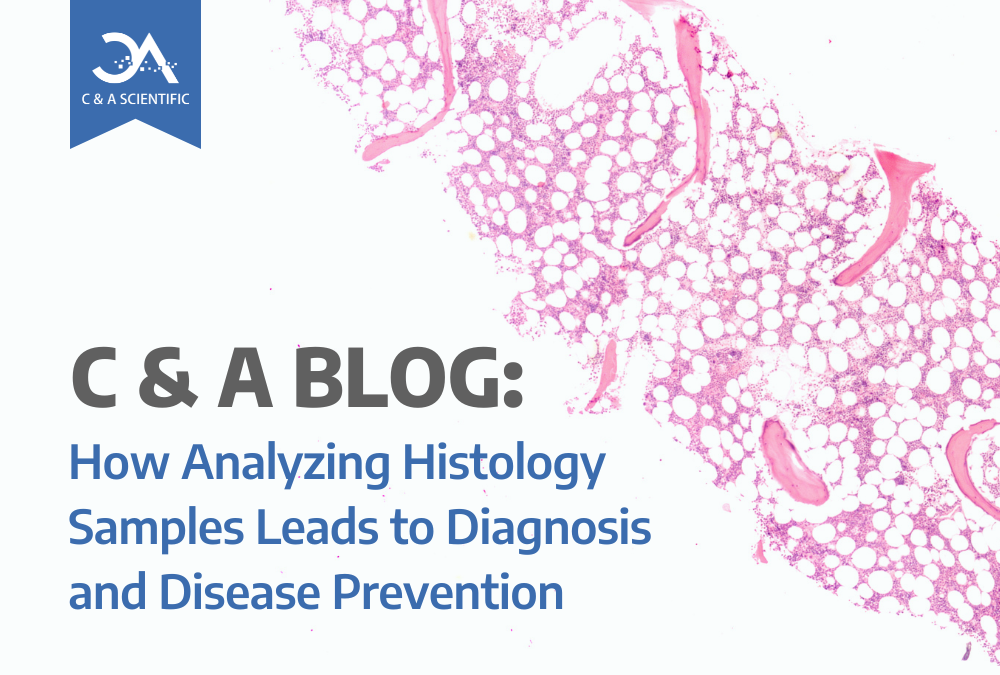
Histology is the study of tissues, their structures, and how diseases impact them in distinctive ways. To study tissue, laboratories prepare and stain microscope tissue sections to look at cell features for analysis.
TABLE OF CONTENTS
- The Importance of Histology
- How Does Histological Analysis Work?
- How Are Histology Samples Analyzed?
- The History of Histology
- Developments in Histology
- C & A Scientific’s Mission
The Importance of Histology
Through histology, we gain vital knowledge of:
- Animal growth
- Biological tissues
- Tissue diseases
- Physiology
We also receive rapid diagnoses, which prevents diseases and points to accurate treatment plans.
Histology aids the research of multiple science fields, including veterinary, medical, and forensics. Now that we know how vital histology is to diagnosing and preventing diseases let’s explore how histological analysis works.
How Does Histological Analysis Work?
Histological analysis works because diseases impact individual cells in many ways. These processes can cause cells to:
- Change shape
- Divide
- Move
- Invade other tissues
- Die
These cell changes may be primary, meaning they cause the disease, or secondary, meaning the disease causes them to occur.

How Are Histology Samples Analyzed?
Histology samples must be stained. Most cells and cellular elements are almost transparent, which makes distinguishing cells and cellular structures difficult if they are not stained.
Typically, hematoxylin or eosin dyes are the stains used for cells. Hematoxylin stains tissue samples blue and is alkaline, while eosin stains samples pink and is acidic.

Researchers analyzing these cells look for proteins that signify a particular cell type or disease. These proteins are called markers. Once sampled, the tissue goes in a solution of wax sealer for sectioning.
Histology technicians cut the sections with various instruments, and the protocol for doing so is specific to the tool and application. Usually, the tissue must be in a medium before cutting.
In routine histology, the typical medium used is wax blocks. The wax block process requires that water be removed from the tissue while being progressively replaced by wax.
The History of Histology
Histological processes were first used in the 1600s in Italy by Marcello Malpighi. Despite this early analysis, researchers didn’t understand that organs are made of tissues until the late 1700s when Marie-Francois Xavier Bichat proposed the term “tissue” to the medical community. He suggested that one can harm tissue within organs without the organ failing.
Histological staining was also first used in the late 1700s. A stain used by early botanists, called carmine, was utilized by John Hill in the 1770s to analyze tissues in ammonia solutions.

Developments in Histology
In the future, histology technicians may use artificial intelligence (AI) to enhance the histologic grading of specimens. The role of AI in histopathology may include preliminary diagnosis and quality assurance.
Histopathology is the study of how tissues are affected by diseases. Histopathology can help determine the severity of an illness and how far it has progressed.
While this advancement may see implementation soon, one downside of AI is that some diagnoses may be overlooked if a dataset is not inclusive.
C & A Scientific’s Mission
C & A is proud to provide equipment that enables high-quality histological research. Diagnosing diseases through histological analysis is a methodology that aligns with C & A’s vision to improve the health and minds of people worldwide.
We are proud to provide equipment that enables high-quality histological research. Find our Histology Catalog here to learn more about the products we provide.
C & A Scientific is a dedicated leader in improving the health and minds of people worldwide. We supply over 700 medical and STEM-inspired products to distributors and retailers looking for sensational customer service. Learn more about us and our story here.

